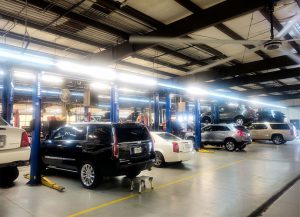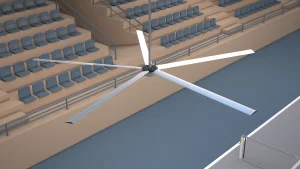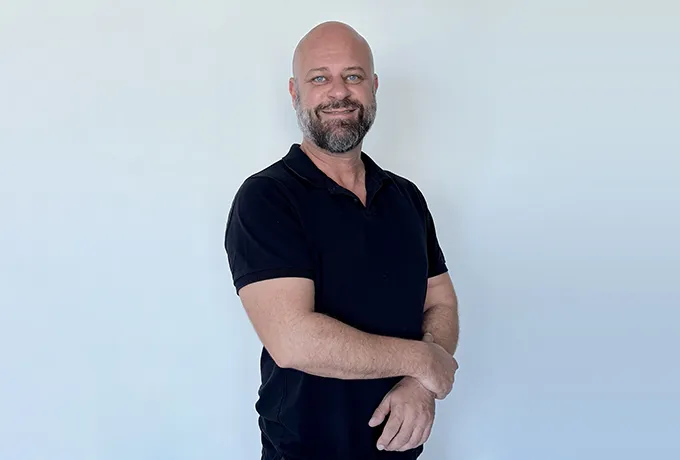Choosing the right fan for your warehouse, gym, or industrial space can be overwhelming. With numerous fan types and configurations available, how do you know which one is the best for your needs? The solution: HVLS fans, designed for high-volume air movement with energy efficiency.
A HVLS fan stands for “High-Volume, Low-Speed Fan,” engineered to move large amounts of air at minimal rotational speed. These fans are ideal for large spaces like warehouses, commercial buildings, and gyms, providing uniform airflow and stable temperature control. HVLS fans reduce energy costs, improve air circulation, and enhance comfort with low-speed fans moving air gently and quietly across vast areas.

HVLS Fans in Action in a Large garage
An HVLS fan stands for High-Volume, Low-Speed Fan. These industrial fans are designed to move large volumes of air at low speeds. Unlike typical ceiling fans, which work best in smaller spaces, HVLS fans are made for large environments such as warehouses, gyms, and commercial spaces.
The fan size is critical when selecting an HVLS fan for your space. Larger spaces require bigger fans to ensure adequate coverage. A fan that’s too small may not move air effectively, while one that’s too large can lead to wasted energy and unnecessary costs.
The height of your ceiling directly impacts the fan’s performance. HVLS fans work best when installed in areas with high ceilings—typically 15 feet or higher. This ensures the airflow is distributed evenly across the space without creating uncomfortable drafts.
Strategic fan placement maximizes airflow. The fan should be centered within the space to ensure uniform coverage. It’s also essential to consider the mounting height to avoid blocking airflow near the floor.
When choosing the right HVLS fan size, consider these factors:
General Rule: For spaces over 20,000 sq. ft., a 20-24 ft fan is recommended, while smaller spaces of around 10,000 sq. ft. will benefit from a 12-16 ft fan.

HVLS Fans In Sports Center Distance
HVLS fans excel in distributing air evenly over large spaces. Their low-speed rotations move substantial amounts of air without the gusts associated with high-speed fans. This means that air circulates evenly across the floor, ensuring stable temperature and air quality.
One of the significant advantages of HVLS fans is their ability to move air gently yet powerfully. Unlike high-speed fans that produce noisy wind gusts, HVLS fans offer a quiet, consistent breeze across the entire room.
When using HVLS fans in conjunction with an HVAC system, the need for air conditioning is reduced. The fans help move the cool air, ensuring that HVAC systems don’t need to work as hard. This leads to significant energy savings over time.
In addition to reducing energy consumption, HVLS fans contribute to an even temperature distribution across the space. This is particularly useful in large warehouses or industrial spaces, where hot spots and cold pockets are common.
Fan installation is key to maximizing the performance of an HVLS fan. Improper installation can result in uneven airflow, reduced fan lifespan, and higher operational costs. Here’s what to keep in mind:
Though some fans come with easy-to-follow installation guides, it’s always best to hire professionals to ensure optimal fan performance. An incorrectly installed fan might cause imbalance or lead to energy inefficiency.
HVLS fans improve thermal comfort by distributing air evenly. In settings like factories or warehouses, employees can work comfortably without dealing with heat stress or stagnant air.
Maintaining a comfortable working environment is essential for maximizing productivity. Cooler temperatures and better airflow allow workers to stay focused and energized. In fact, research shows that employees perform better when they are comfortable.

HVLS Fans Help Improve Comfort and Productivity
Traditional ceiling fans typically spin at high speeds to move air, which can be noisy and ineffective in large spaces. HVLS fans, however, rotate slowly but move high volumes of air at low speeds.
Traditional ceiling fans are effective in small spaces but fail to cover large areas adequately. HVLS fans, with their wide blade diameter, can effectively cover large industrial spaces, providing consistent airflow throughout the room.
To extend the lifespan of your HVLS fan, regular maintenance is required:
For optimal performance, it’s advisable to have a professional service your fan annually, especially if the unit runs for long periods.
When choosing the right HVLS fan, take into account:
Key considerations: Get the right fan for your space to avoid underperforming or wasted energy. Consulting with an HVLS expert can guide you in choosing the optimal solution for your needs.
What is the lifespan of an HVLS fan?
An HVLS fan can last 10-15 years with proper maintenance, making it a long-term investment for your business.
Can I use an HVLS fan in an outdoor space?
Yes, many HVLS fans are suitable for outdoor or partially enclosed areas like pavilions or open warehouses, as long as they are rated for weather resistance.
Are HVLS fans expensive to install?
While the initial cost may be higher than traditional fans, the long-term savings in energy and maintenance make HVLS fans a cost-effective solution for large spaces.
How do I choose the right size of an HVLS fan?
The size of the HVLS fan depends on the size of the space and ceiling height. Larger spaces require bigger fans for optimal airflow and coverage.
In conclusion, HVLS fans stand out in providing high-volume air circulation for large spaces. Whether you’re managing a warehouse, gym, or commercial building, these fans offer consistent air movement, increased thermal comfort, and reduced energy costs. Their ability to cover large areas with minimal noise and energy consumption makes them an ideal solution for businesses looking to improve indoor environments and lower overhead costs.
Ready to transform your space with the power of an HVLS fan? Contact us to choose the perfect fan solution tailored for your business needs!

Hi, I’m Michael Danielsson, CEO of Vindus Fans, with over 15 years of experience in the engineering and design industry. I’m here to share what I’ve learned. If you have any questions, feel free to contact me at any time. Let’s grow together!